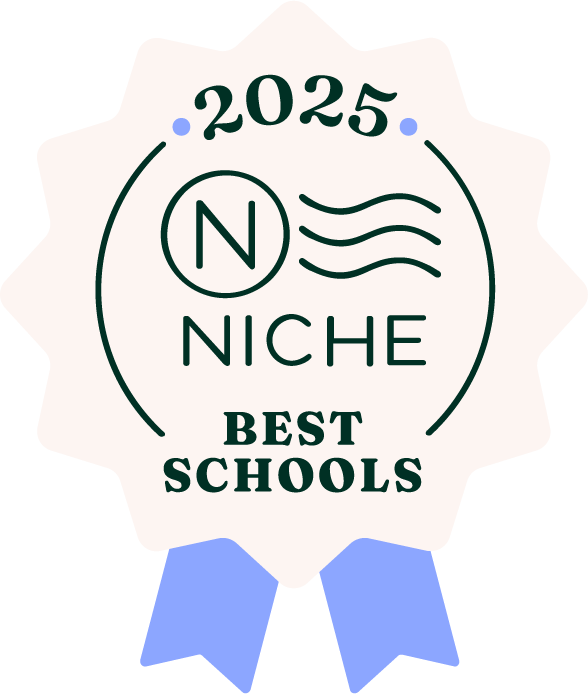You may have noticed an unusual orange fruit popping up everywhere on campus. You may even have asked, "what is that?"
Originally from Asia, and morphologically considered a berry, the persimmon is a lovely fruit that matures to a deep orange color in late Autumn. If you’ve ever visited Greensboro Montessori School's Primary Garden, you’ve probably noticed our beloved persimmon tree, planted over 20 years ago by master permaculturalist, Charlie Headington. In the years since, this tree has been lovingly pruned and harvested by our favorite garden coordinator, car line greeter, facilities assistant, and student support pal, Aubrey Cupit.
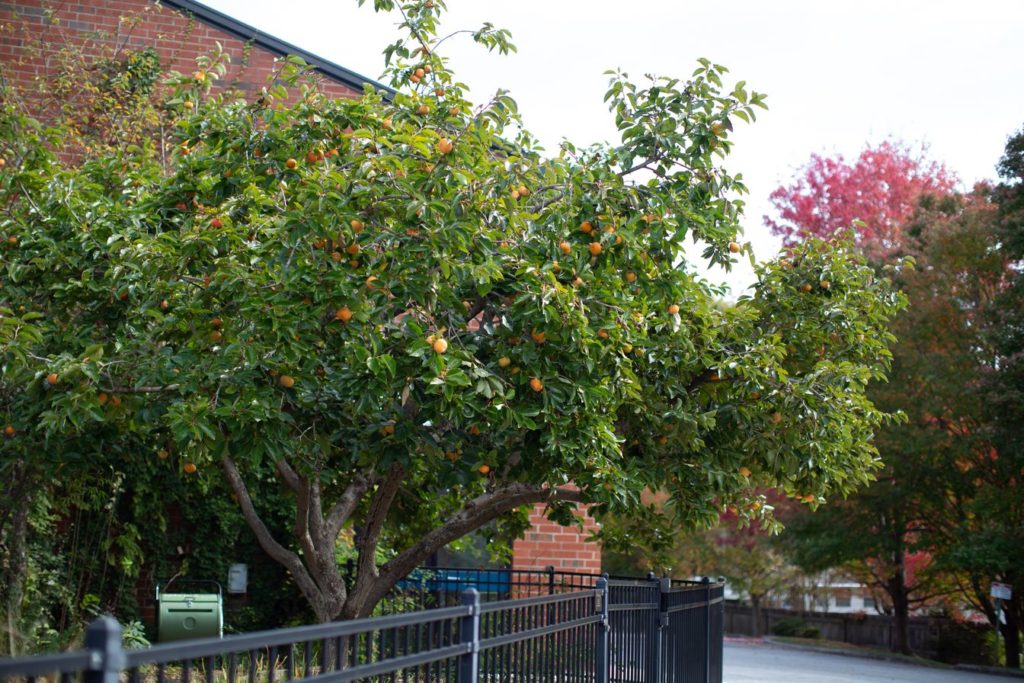
Generations of GMS students share a collective nostalgia for the flavor of the persimmon. To them, it seems a rare, exotic fruit with notes of magic and pure joy only attainable from our grounds. Students begin asking for persimmon snacks in our Environmental Education classes on the very first day of school, and then every subsequent day until we cut into the first ripe persimmon in October. It would be difficult to adequately describe the infectious wave of excitement when our students find out we are having persimmons for snack.
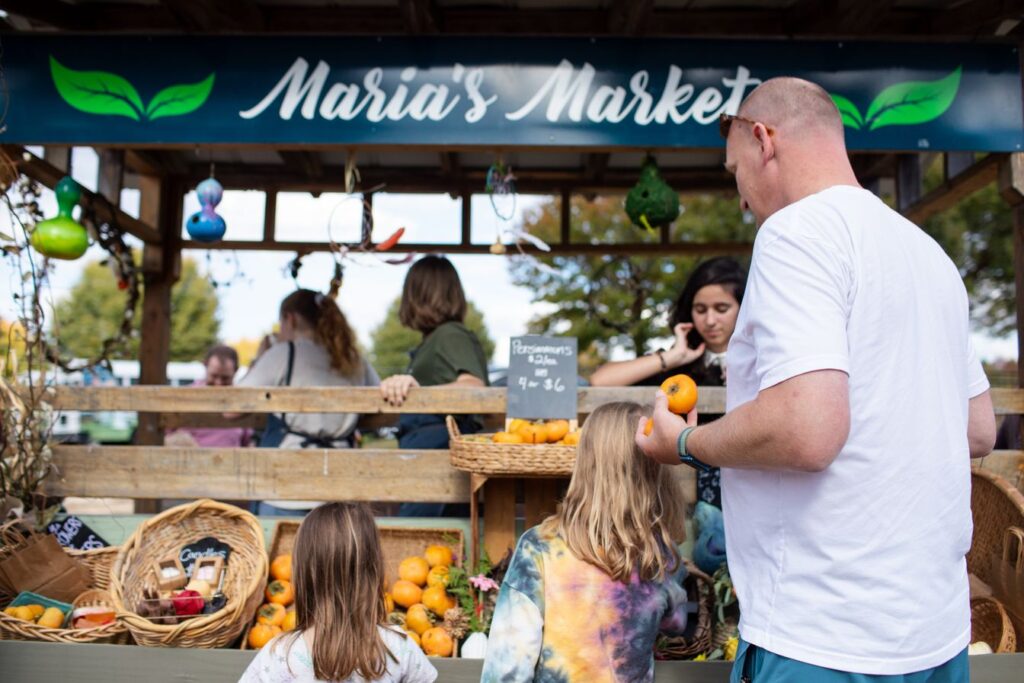
A firm persimmon tastes like a combination of honey, peach, and mango, with earthy undertones and the texture of an apple. For those unfamiliar with this fruit, I would recommend eating it raw, just like an apple, skin and all. Others prefer to bake softer persimmon pulp into pancakes, bread, or cookies. Persimmons work well in savory applications such as persimmon vinaigrette and other meat-based dishes akin to pork and apples. Dehydrated persimmon pulp creates a delicious fruit leather, while dehydrated persimmon slices make an excellent snack.
Each of the five persimmon trees on campus have produced bountiful fruit this season! Our students have reveled in their tastings during Environmental Education lessons and our Junior High Culinary Arts team has been baking with them voraciously! Word on the street is there's a tasty recipe for persimmon scones going around.
Additional Resources
- NPR: Ancient Japanese Food Craft Brings Persimmons To American Palates
- Martha Stewart: 13 Persimmon Recipes Everyone Should Make This Fall
- Wikipedia: Persimmon
Greensboro Montessori School hosted two teacher workdays this fall, each dedicated on professional development. Classrooms were closed giving our team uninterrupted time to focus on learning new skills and growing as educational professionals. So how did the team use their time?
During our September 20 workday, faculty paused to reflect on the work we do with students every day and our approach to guiding them in their meaningful work. Nancy VanWinkle, instructional coach, and Jessica White Winger, director of student support, led a workshop designed to build teachers’ tool sets for preparing the environment, particularly expanding the resources of the prepared teacher. The theme was building a “Community of Reflective Practitioners,” with a focus on leveraging the collective experience of the educators in the room.
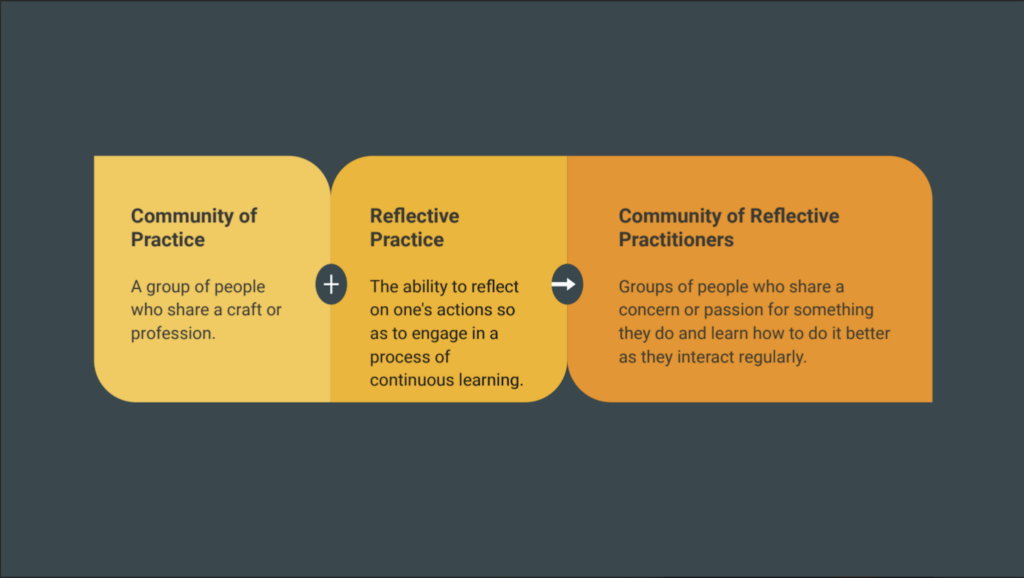
Teachers worked in mixed-division groups, with varying years of experience in the field. The morning opened with a grounding activity in which teachers were shown photographs of individuals who have affected positive change in the world. These individuals have raised awareness around difficult issues, often putting their lives and work at risk to do the “right” thing. Teachers were asked to work with their groups to list the qualities of one of those changemakers. Following a share-out, the group reflected on how we can encourage these qualities in all of our students. This impactful exercise grounded us in the knowledge that each child is under “self construction” and we have the big responsibility of allowing their true light to shine, while helping guide them in becoming their best self.
Following this exercise, Nancy and Jessica shared what resources and experiences they have to support teachers during the 2023-24 school year. As our instructional coach, a role dedicated to support faculty in their professional development, Nancy worked closely with Jessica to design a collaborative problem-solving approach for schoolwide implementation. The model offers teachers a practical tool for seeking input from one another and leveraging the cumulative knowledge of our faculty and staff.
This collaborative problem-solving model has teachers sharing a specific behavior they are experiencing with a child in their classroom. A group of educators, with one facilitator and one recorder, reflects on the overall question, “What’s going on with this child?” and what are the unmet needs, lagging skills, or obstacles that the student might be encountering? By looking at the heart of the issue, we honor the child and seek to better understand what their behavior is telling us. The facilitator then takes the group through a series of brainstorming questions, while the recorder writes strategies and suggestions. In the end, the teacher chooses a strategy to try out for a week and agrees to report back to the group. At that point, they may revisit the brainstorm and select another strategy to try.
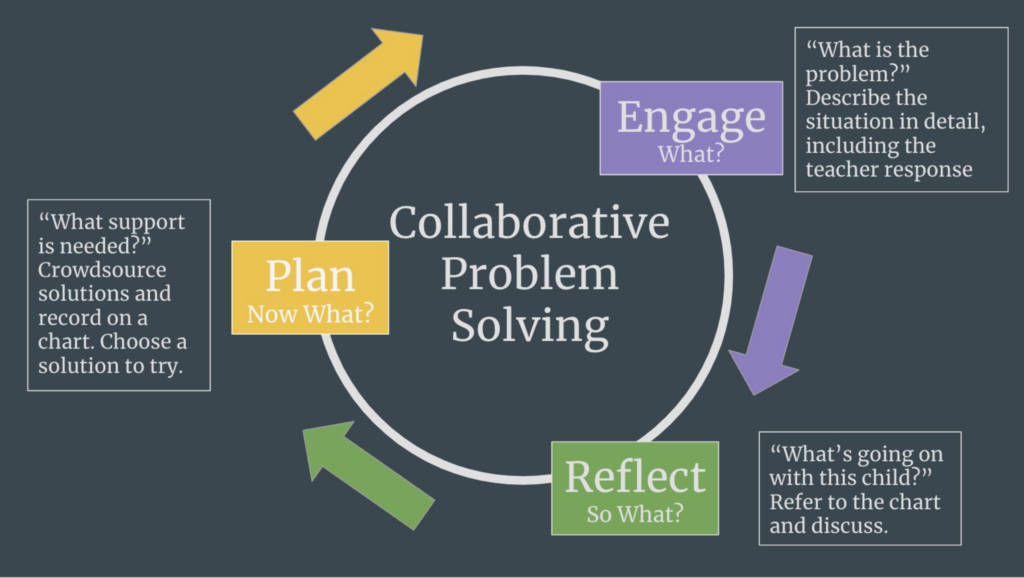
After modeling this process for everyone, teachers split into their mixed-division groups to practice the model. The value of this collaborative approach is vast, as it’s an opportunity for teachers to gain new perspectives and insight, helping create a shift in paradigm and introducing new ways of responding to student needs. It’s about connecting with colleagues and taking a child-centered approach, as much as it’s about reflecting on our own vulnerabilities and finding strength in the process. It is not about “fixing” a behavior, but opening ourselves to trying new approaches and embracing the spirit of the child.
During our October 6 teacher workday, our group of reflective practitioners reunited to share how our new system of collaborative problem solving is helping them in the classroom. Mixed-division groups reported out on strategy successes and areas of growth. More teachers had the opportunity to share a new challenge with their groups and seek strategies to try. Faculty feedback for this process has been overwhelmingly positive, and we are excited to be working closely together to authentically support students and to address their most critical needs.
Teachers spent the latter half of the workday looking at the scope and sequence of their Montessori curriculum, evaluating it with a fine-toothed comb to ensure fidelity and best-practice in every classroom. This “big work” is just one more way we are reflecting on our practice and ensuring that every student at GMS is engaged in meaningful work as they progress from Toddler through Junior High.
Through intentional planning, we make professional development at GMS relevant and meaningful. We consistently follow-up with faculty to ensure we are meeting their needs and supporting their professional growth. From workshops, trainings, and conferences to observations at other schools, professional development offers inspiration and connection for GMS teachers.
Over the course of the next few months, nearly half of the Toddlers in our School will be making a foray into the wonderful world of Greensboro Montessori School's Primary program. This transition brings with it a mixed bag of emotions for young children (not to mention their parents and teachers). Though the idea of becoming one of those big kids in the enchanting world on the other side of the playground fence can be very exciting, the thought of leaving behind beloved teachers and classmates and mastering the challenging materials in the Primary classroom can be very daunting for advancing toddlers. At times, well-meaning adults discuss this transition in ways that can actually heighten young children's apprehension. Here are a few things to consider as we prepare our little ones for a classroom transition:
Avoid "overtalking" about the impending changes. For adults, having ample opportunity to ask questions and share our feelings about an upcoming transition can be a comfort. We may worry that our children won't know what to expect from their new classroom unless we initiate frequent discussions and provide ample detail. For young children, though, too much information can be overwhelming and confusing. Because they learn experientially, young children may not grasp the reality of how things will feel in their new classroom until they have physically visited the space, met the teachers, and absorbed the sights, sounds, and sensations first-hand. It's perfectly fine to mention the change - conveying that you are excited about it and confident in their readiness for the new classroom - but, for the most part, it's best to follow your child's lead. The most helpful discussions will be the ones your toddler initiates!
Avoid tying new skills to Primary advancement. It can be tempting to entice children to practice new skills by pointing out how important they are for Primary students. However, suggestions that toddlers learn to use the potty, dress themselves, or tackle other developmental tasks "so they can go to Primary" can sometimes backfire. Even children who seem excited about the prospect of "moving up" can harbor anxieties about the transition ... and may not be so sure they really want to go. In fact, they may even delay the acquisition of self-care skills to avoid the prospect of being moved into a new and unfamiliar environment. It's wonderful to express the love and pride you feel when your child attains a new milestone, but keep the topic entirely separate from expectations that may be attached to their classroom placement.
A few setbacks are perfectly normal. At times, parents are surprised to find that their "big kids" suddenly takes three steps back in behavior, separation anxiety, or even toileting before or during classroom transitions. Don't worry; this too shall pass. Translated from the toddler speak, these setbacks are children's way of asking whether they will still get the nurturing and support they relished as infants and toddlers, even though they are heading into big-kid territory. A little extra cuddling and reassurance will help your child get back to their independent ways in time.
Rest assured, you are in for a treat! Call us biased, but we're not exaggerating when we say that the Primary faculty at Greensboro Montessori School is one of the most talented teams imaginable. You'll be astounded by the many ways your child will learn and grow during the Primary years - and by the dedication and expertise of their teachers. Watching children leave our classroom nest is the hardest part of teaching, but knowing they are going into such incredibly dedicated and capable hands makes things much easier. We can't wait to gaze at our "alumni" over the playground fence next year, and marvel at the ways they are spreading their wings!
Dr. Maria Montessori was nominated for the Nobel Peace Prize in 1949, 1950, and again in 1951. Dr. Martin Luther King, Jr. was awarded the Nobel Peace Prize in 1964, becoming the youngest man to receive the honor at the time. They were both influenced in their work for peace by Mahatma Gandhi. In the 1930’s Maria Montessori met Mahatma Gandhi while she was living in India, and Gandhi gave a speech to Montessori teachers in training in London in 1931. There he said of her work, “You have very truly remarked that if we are to reach real peace in this world and if we are to carry on a real war against war, we shall have to begin with children.” While Dr. King did not meet Gandhi in person, he referred to him as “the guiding light of our technique of nonviolent social change.”
These three peacemakers have been great influencers across cultures. Dr. Montessori established educational training programs that have led to thousands of schools all around the world. Dr. Martin Luther King, Jr. organized peaceful protests that changed civil rights laws in the United States and inspired future peaceful protest around the world. They all changed the world through peaceful efforts.
At Greensboro Montessori School, we implement the peace curriculum at every age level - from guiding toddlers to self calm to teaching peaceful conflict resolution in our preschool and elementary classrooms, to visiting the United Nations in Junior High. We seek to provide experiences for children to understand and access the peace within themselves, to relate with other people, cultures, and the environment, and to embrace the complexity of humankind. When children are given opportunities to practice peace within themselves, they will be able to share it with others and seek it out in the world.
Dr. Martin Luther King, Jr. said, “The function of education is to teach one to think intensively and to think critically.” These peacemakers have influenced generations. And inspired by their work, Greensboro Montessori School is educating the next generation of peacemakers and innovators.
After a long day away from our children, we parents are eager to hear all the details about how they have spent their time. However, so often our queries of “What did you do today?” are met with the same predictable response: “Nothing.” For children, distilling the many details and experiences of a full day at school into an anecdote or two is a tall order. What tools can we use to get them talking about their learning?
Vidigami
Through the Vidigami private photo sharing platform, you get to see moments of your child’s day at school. Viewing photos of your child engaged with Montessori materials can inspire great conversations. Children, especially those younger than five, are not yet able to summarize and describe the many things they experience over the course of a full and stimulating school day. However, photos offer visual cues that trigger a child’s memories and invite them to comment on specific materials and activities. There are many different ways to talk about these photos with your child, and we've provided some suggestions, which focus on your child's intrinsic motivation. Enjoy these special conversations as you allow them to teach you what they are learning at school.
- Ask your child to tell you about the photo. You may learn what they see in the classroom, or what they remember about the moment, and it may be much more than meets the eye.
- Say what you see without judgement. “I notice you are in the classroom.” “Do you know the name of that work?” “There are a lot of colors in your drawing.”
- Speak about their efforts instead of praising their product. “You really look like you are concentrating.” “Is that the first time you have done that work?” “I see your smile. What did you like about that work?” “Are you building with those blocks?”
Intrinsic Motivation
Listening to your child talk about the photos and speaking without judgement encourages your child's intrinsic motivation – it allows them to continue to work for their own sake, rather than for any praise from adults. As Montessori teachers, we get to witness this intrinsic motivation every day. It looks different at each age grouping and is a critical element to Montessori education. Many elements of the method foster intrinsic motivation without reward and judgement, such as control of error in the materials, allowing for repetition, assessment through observation, and relying on peers as sources of feedback and inspiration. Teachers try never to interrupt a concentrating child or judge their work. Instead, they seek opportunities for meaningful conversations before or after a student's work cycle.
As Montessori observed children, she saw time and time again the intrinsic motivation in the child to work through repetition for long, uninterrupted periods of time. In a book that examines Montessori’s relevance to today’s educational practices, "The Science Behind the Genius," Angeline Lillard refers to several current research studies confirming that rewards and punishments not only negatively impact intrinsic motivation, but also how a student performs on the task. Traditional reward methods used in most schools may actually hinder a child’s performance. Given the opportunity, children are capable of learning to take personal responsibility for their actions.
“Like others I had believed that it was necessary to encourage a child by means of some exterior reward that would flatter his baser sentiments … in order to foster in him a spirit of work and of peace. And I was astonished when I learned that a child who is permitted to educate himself really gives up these lower instincts.” – Dr. Maria Montessori
My very first year at Greensboro Montessori School, I worked alongside a wise and wonderful teacher, who is also my Montessori mentor. As our year together progressed into late spring, she suggested we teach a unit on the life cycle of the monarch butterfly and sent me afield to pick up a caterpillar tent from a local butterfly farm. It was a curious-looking contraption: a flowering milkweed plant with a gauzy covering. A week into our journey with this kit, my mentor had a family emergency that took her on an unexpected trip overseas ... for four weeks. At a moment’s notice, I found myself entrusted with the care of 12 children; one gerbil (my mentor knew I didn’t do rodents); a ragtag tray of fava beans sprouting in paper cups; and this milkweed plant, the presumed setting for the miracle of metamorphosis. That is, if I could keep it alive. It didn’t take long for me to realize that with this lowly plant came some extraordinary lessons in faith, respect, awe, tenderness, and trust.
 For those uninitiated in the art art of raising caterpillars: they take a while to become visible. A long while. Though we’d been promised that our plant came with a pair of Monarch eggs, those first two weeks rolled by with nary a sighting of the little beasts. Every day we checked for them, and every day I saw the skepticism grow in my students' eyes as I described the wondrous sight we were going to behold. Probably. Eventually. The morning we finally noticed wormholes in the leaves — evidence that our charges were indeed hatched and hungry — felt like waking up to breakfast in bed on your birthday.
For those uninitiated in the art art of raising caterpillars: they take a while to become visible. A long while. Though we’d been promised that our plant came with a pair of Monarch eggs, those first two weeks rolled by with nary a sighting of the little beasts. Every day we checked for them, and every day I saw the skepticism grow in my students' eyes as I described the wondrous sight we were going to behold. Probably. Eventually. The morning we finally noticed wormholes in the leaves — evidence that our charges were indeed hatched and hungry — felt like waking up to breakfast in bed on your birthday.
Once our caterpillars became visible, they grew at a blazing speed, delighting the toddlers with their impossibly lovely stripes and ravenous eating habits. The students relished the idea that these creatures never, ever accepted any food but milkweed. “Wouldn’t you like some pizza, dears?,” I’d ask the worms. “Maybe a nice cup of coffee?” The children would squeal, “NO WAY!,” perhaps reminded of their own choosy appetites. An assortment of suggested names were bandied about, ranging from Lexy to Tiger to Dobo to Burp. (The caterpillars didn’t seem to have a preference.)
 One sunny morning, we found the caterpillars hanging from the leaves in their mysterious “J” formation, the behavior that immediately precedes the formation of the chrysalis. Within hours, they were caterpillars no more. If I had not seen it with my own eyes, I could never have imagined the reverence and care the students extended once this transformation had taken place. They seemed to instinctively know their tiny pets now needed silence and space. Each morning, the toddlers took turns standing guard by the milkweed plant, gazing solemnly at the astonishing beauty of the chrysalises, misting them gently with a spray bottle. Many days of inaction followed ... yet, having awaited their friends’ first emergence, the students now had unwavering patience and faith. Some miracles, they’d learned, are worth waiting for.
One sunny morning, we found the caterpillars hanging from the leaves in their mysterious “J” formation, the behavior that immediately precedes the formation of the chrysalis. Within hours, they were caterpillars no more. If I had not seen it with my own eyes, I could never have imagined the reverence and care the students extended once this transformation had taken place. They seemed to instinctively know their tiny pets now needed silence and space. Each morning, the toddlers took turns standing guard by the milkweed plant, gazing solemnly at the astonishing beauty of the chrysalises, misting them gently with a spray bottle. Many days of inaction followed ... yet, having awaited their friends’ first emergence, the students now had unwavering patience and faith. Some miracles, they’d learned, are worth waiting for.
When the butterflies emerged during the last week of school, we carried them to the playground and prepared to set them free. Before they departed, they allowed each and every toddler to hold them awhile and sing them a send-off song (the choice was painfully obvious: “Let it Go”). When the monarchs finally took to the sky and fluttered toward the Primary garden, I knew the students and I were feeling the exact same mix of elation and heartache. After all, many of our toddlers themselves would soon be flying to the other side of the playground fence, away from the nest of our classroom and our many loving days together.
 Six years later, having raised monarchs with every single toddler class I’ve taught since that first year, it’s time for my own metamorphosis. I am so excited for the new challenges and relationships that await me as I transition into the director of CASA role at Greensboro Montessori School. Yet there’s something about teaching that simply can’t be matched by any other profession. Year after year, I’ve witnessed the beautiful metaphor of little children caring tenderly for the tiny, fragile caterpillars whose lives begin in our classroom. I hope that’s in small part because they, too, have felt tenderly cared for here; that they understand the reverence and awe a teacher experiences as they watch their students grow, and the bittersweet pride they feel when it’s time to set their students free.
Six years later, having raised monarchs with every single toddler class I’ve taught since that first year, it’s time for my own metamorphosis. I am so excited for the new challenges and relationships that await me as I transition into the director of CASA role at Greensboro Montessori School. Yet there’s something about teaching that simply can’t be matched by any other profession. Year after year, I’ve witnessed the beautiful metaphor of little children caring tenderly for the tiny, fragile caterpillars whose lives begin in our classroom. I hope that’s in small part because they, too, have felt tenderly cared for here; that they understand the reverence and awe a teacher experiences as they watch their students grow, and the bittersweet pride they feel when it’s time to set their students free.
This year, when our current crop of monarchs depart for the great big world outside, we’ll all be ready to spread our wings and join them, together, in flight.
 About the Author
About the Author
Brooke Juneau joined Greensboro Montessori School's Toddler faculty in 2013. She holds her Infant & Toddler (bith to 3 years old) Montessori teaching credential and graduated from Hampshire College with a Bachelor of Arts in education and human development. Brooke is the mother of three boys. Her middle son, Hayden, graduated from Greensboro Montessori School in 2017. Brooke plays the guitar and loves singing with her students. Beginning in the 2019-20 school year, Brooke will be the School's director of CASA.
Greensboro Montessori School's Junior High student council members usually plan three dance parties a year, one each in the fall, winter, and spring. Whether an upcoming dance is your child's first or they have attended these kinds of functions before, we have some details to help you plan ahead.
When: Greensboro Montessori School dances are on a Friday night from 7 to 9:30 p.m.
Where: Dances are hosted in Greensboro Montessori School's Gymnasium
Who: Attendance is limited to currently enrolled students in grades six through nine. In general, students may not bring guests from other schools. In some instances, Greensboro Montessori School has invited other independent schools in the Independent School League to attend dances, but this is the exception to the rule.
Attire: Students may choose to dress up or wear regular clothing. Attire must follow Greensboro Montessori School's dress code. We ask all attendees to wear soft-soled shoes that will not scuff or leave marks on the gym floor.
Chaperones: All dances are chaperoned by faculty and staff from Greensboro Montessori School. On the night of the dance, parents may drop-off their child at the Gymnasium entrance at 7 p.m. and return at 9:30 p.m. when the dance is over. The School always provides the name and cell phone number of at least one chaperone in a personal email to parents.
Cell phones: Students are permitted to bring cell phones to dances.
Entrance Fee: Students pay $5 cash at the door to attend dances.
Music: All Greensboro Montessori School dances have a DJ who is a current student. They develop a playlist based on student requests and submit this playlist for review by their faculty advisor. The faculty advisor reviews the list for content and language and approves only those songs which are age appropriate.
Have you ever been reminded of an Abbott and Costello skit when talking with your three year old? Ever fallen down a rabbit hole of questions, only to hit the rock bottom of your ability to come up with an answer? If so, you have encountered the phenomenon that is the "Why?" stage. Where does this dizzying vortex of inquiry come from? And, more importantly, when will it stop?
"Get your shoes on, honey. We're going to the store."
"Why?"
"Because we need groceries."
"Why?"
"Because we ate up all our food."
"Why?"
"Because we were hungry."
"Why?"
Maria Montessori provides us with profound insight into the seismic shift in children's cognitive development that takes place around the third birthday. Before this milestone, infants and toddlers are "unconscious, absorbent" learners who acquire skills such as walking and talking without self-awareness or intention, by simply following their own innate desire for autonomy and imitating others in their environment. Around age three, however, they become "conscious" learners, who actively seek knowledge and master new skills through purposeful, deliberate inquiry and practice. It is around this time that many children stumble upon a magical word; one that elicits a seemingly endless wellspring of useful information from adults. Thus begins the litany: "Why? Why? Why?”
In truth, a child's "why?" is not the same question we ask as adults. Yes, children do crave our explanations as they seek to understand their world, but they are not necessarily expecting any elegant, logical, or scientific answers. More often, "why?" translates to: "I'm curious about this topic. I like it when you explain what will happen next. I cherish your attention and the love I feel from you when you talk to me. I want to hear all of the words you know so that I can learn how to use them, too. I want to use long sentences and have conversations, just like you do. Let's practice talking together!" Like a game of verbal ping-pong, each thread of "whys" and responses helps children develop engaging, socially adept conversation skills that will serve them well throughout their lives.
For a great perspective on the whys behind "why," click here for a great article from child psychologist Dr. Alan Green. And to learn more about Montessori's research on the developing brain, please visit our Parent Resource Library, or ask your child's teacher at GMS. (Why? Because we love talking about this stuff.)
A toddler is seated at a small table, carefully guiding a toothpick through the tiny hole in the top of an oil & vinegar shaker. Beside him, a classmate pours water into a vase before adding a few small stems of flowers. Nearby, a teacher and children use blunt slicers to prepare cucumbers for the morning snack. Scenes like these are hallmarks of the Montessori toddler classroom, and look quite different from many other early childhood settings.
To the unaccustomed eye, the purpose of these activities, cobbled together from seemingly random household items, can be difficult to discern. But upon close inspection, one notices that the first child holds the toothpick with a grasp closely resembling the pencil grip he'll eventually master. His classmate is developing focus and concentration as the flowers engage her senses of sight, smell, touch, and aesthetic awareness. And those involved in the preparation of the healthy snack are now inclined to sample it themselves. The holidays, with their family feasts and seasonal crafts, are a great time to bring new Practical Life work into your own home!
Practical Life work extends far beyond a single shelf in the classroom. It comprises the child-sized mops, brooms, and window-washing materials; the boots that beckon a child to practice removing and replacing his shoes; the watering can being carefully hauled between the sink and the classroom plants; the dishwashing table awaiting the morning's plates and cups; and much more. These materials and experiences are deeply enriching to the toddler's developing sense of self. Practical Life activities:
- Promote a sense of pride and ownership in the classroom environment.
- Enable children to interact with real-world objects, mastering the use of tongs, juicers, tweezers, rakes, basters, and other implements they'll encounter for the rest of their lives.
- Enhance physical coordination, promoting both large and small muscle development.
- Build independence and self-esteem by providing toddlers opportunities to care for themselves.
- Convey a sense of trust between caregivers and children, communicating that we see them as capable and worthy of using the real tools, kitchen devices, and other household items they long to explore but are often forbidden.
- Allow children the gratification of completing a defined task from start to finish.
Best of all, these activities are some of the easiest to duplicate in the home environment. Many parents are surprised to discover how much their toddlers enjoy simply pouring water from one cup to another, matching socks from the day's laundry, or using a whisk broom and dustpan to help with sweeping. The results aren't always perfect, yet every experience brings a child closer to mastery of these helpful household skills. A little time, space, and patience now can create young children who are eager and capable helpers down the road. And nothing quite compares to the pride on a child's face - and in a parent's heart - when they work and succeed together!
These websites offer some great ideas for creating Practical Life experiences at home:
www.LivingMontessoriNow.com
www.montessorimom.com/practical-life/
www.howwemontessori.com/how-we-montessori/practical-life/
With Greensboro Montessori School's tuition payments dedicated to covering Greensboro Montessori School’s operating expenses, grants from the Annual Fund provide the necessary resources to make our School more than excellent - to make us truly exceptional. Through the benevolence of parents, alumni, community partners and friends of the School who give to the Annual Fund, Greensboro Montessori School is able to award grants biannually to teachers and students with specific classroom needs or transformative ideas or both!
Current year grants are funded by the previous year's giving. Contributions generously given and humbly received from last year's Annual Fund have begun taking shape through five grants awarded this fall. They range from simple classroom enhancements for our littlest students to significant technology investments for our elementary programs to supplies for creating a new ecosystem on campus (starring chickens) for our oldest scholars.
- Better Sleep for Growing Toddlers: The Academic-Day Toddler class received three new, high-quality Roman shades with blackout liners to help students get better sleep during nap time. While shades may seem simple to us, anything to promote sleep for our littlest students is transformative. The National Sleep Foundation says, "sleep is especially important for children as it directly impacts mental and physical development...During the deep states of [Non-Rapid Eye Movement] sleep, blood supply to the muscles is increased, energy is restored, tissue growth and repair occur, and important hormones are released for growth and development.
- Reading and Technology Resources for Lower Elementary: With four new Dell Chromebooks and a Raz-Kids subscription, the Lower Elementary program has increased access to age-appropriate, education-based technology. With dedicated laptops in the classroom, students will learn techniques for effective and safe online research and word processing skills. They will also be able to easily practice coding and have seamless access to their Raz-Kids online reading comprehension program. Furthermore, the use of PCs in Lower Elementary prepares students to be "bilingual" in the computer world. In many instances, we as adults use Apple products at home and PCs at work, or vice-versa, so ensuring our student have access to both platforms is important.
- iPads for Elementary Artists: In a continuation of Katherine Gwynn's exploration of the symbiotic relationship between creating with technology and hands-on art making, Greensboro Montessori School's art studio is now home to five iPad Airs and an iPad Pro. Students will integrate drawing, painting, digital photography, digital storytelling, animation and more through these new resources exclusive to our art curriculum.
- Chickens for Middle School Entrepreneurs: After 18 months of planning by students in the R&D (research and development) career track, the Middle School is developing a new ecosystem on campus for chickens. Working closely with Aubrey Cupit, Greensboro Montessori School's garden manager and owner of Gate City Harvest, Middle School students are building a mobile chicken coop, complete with a heat lamp, waterer and feeder for six chickens. Egg production will support the Land Lab, Maria's Café and other microeconomy programs. The coop will also include a technology cart with solar panels to power the coop's heat lamp. The mobile solar panels will also complement science lesson and provide a new power source at the Land.
- Ice for Bumps, Bruises, Food Prep, Entertaining and More: Until recently, we've been stocking our freezer with bags of ice. With a new industrial-grade ice maker, we've traded-out the ongoing cost of purchasing ice with a once-time cost to help us make it on our own (how Montessori of us)! The new ice maker supports the entire student-population ensuring a relatively unlimited supply of ice packs for minor student injuries. This resource will also keep our water and lemonade cold for guests at community events like the Fall Festival, Green & White Bash and End of the Year Pizza Party. Lastly, the Middle School will enjoy easy access to ice for Maria Café and trips to the Land.
Our fall grants are as varied as they are inspiring, but there are two things which bind them all. They are not only the result of giving, but also the reason for giving.
For everyone who has given in the past, is giving today or will give in the future, thank you for supporting Greensboro Montessori School. We are who we are because you have invested in us, and we promise to pay it forward by investing everything we can and all that we have in our students.


